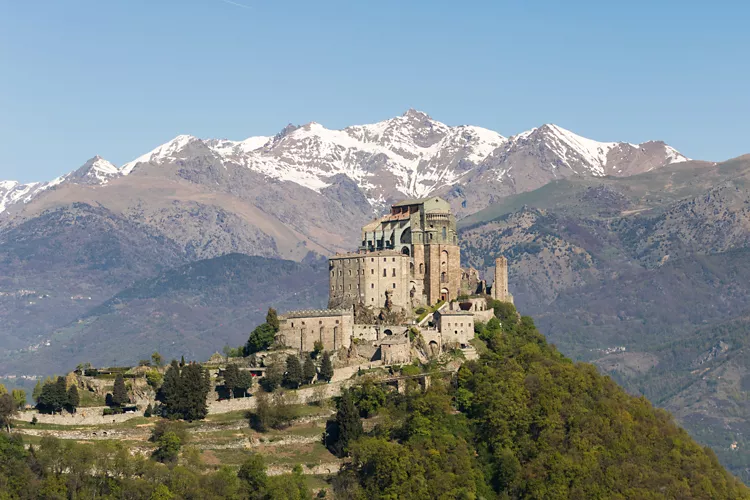
Overview
The Sacra di San Michele in Val di Susa, the abbey that scales the sky
The Sacra di San Michele in Val di Susa is almost 1,000 metres high atop Mount Pirchiriano. The abbey that inspired Umberto Eco to write his novel The Name of the Rose is a masterpiece. The symbolic Piedmontese monument is also the first Italian stop on the Via Francigena. The entire Alpine valley in the western part of Piedmont can be seen from the heights of its towers.
From Roman castrum to Romanesque church
The first church was built around 983-987. Legend has it that the archbishop of Ravenna Giovanni Vincenzo, who lived as a hermit here, had a vision: the Archangel Michael himself commanded him to build a sanctuary, which was later consecrated by angels. Thus the oldest nucleus of the abbey was born.
The arrival of the Benedictines
The church was gradually expanded with a crypt and a small coenoby to accommodate monks and pilgrims passing along the Via Francigena. On top of the primitive church in the 12th century, the New Church was built in Romanesque-Gothic style, on the highest point of the mountain.
The New Monastery, now in ruins, was built shortly afterwards to improve the daily life of the Benedictine monks. New cells, kitchens, a refectory, workshops and a library were built. The Sacra became an important centre for culture and spirituality.
Up to heaven and beyond
The construction became more and more daring. From an altitude of 962 metres on Mount Pirchiriano, it rose to a height of 1000 metres. The colossal stone façade rises 40 metres against the sky. Truly dizzying. Right here, at the main entrance, stands the statue of St Michael, more than 5 metres high and sculpted by Paul dë Doss-Moroder.
The Rosminian Fathers and the Savoy royal family
The Benedictine era ended in 1622. Only three monks remained, then, and the Sacra was abandoned for several centuries. It was only in 1836 that it was reopened, this time by the Rosminian Fathers, who were also entrusted with the care of the deceased members of the Savoy royal house. The bodies, transferred here from the cathedral of Turin, now lie in the Ancient Halls. Since then, the Sacra has remained a place of peace with the exception of a turbulent raid during the Second World War, when the abbey was stormed by German soldiers.
The Staircase of the Dead and the Zodiac Gate
It is so called because the staircase was lined with a great number of tombs and skeletons of monks arranged in recesses along the entire height of the staircase, where they remained until 1936. Climbing up the staircase, here and there you can see the living rock on which the monastery was built. Brace yourself, there are 243 steps to the top!
At the end of the staircase is the fascinating zodiac door, with the doorposts decorated with zodiac signs and constellations carved in stone to remind us of the inevitable passage of time. If you look closely, you will also catch a glimpse of the capitals depicting Cain and Abel, three people fighting and pulling each other's hair, and two women feeding snakes.
The Bell'Alda Tower
On the north side of the complex, set apart from the rest, is the tower of the Bell'Alda, which is linked to the legend of a maiden fleeing from a group of soldiers. She was cornered at the top of the tower, with no way out, and chose to throw herself into the precipice rather than be captured. Angels rushed to her aid and saved her. When she told the village what had happened, no one believed her. So she threw herself off the tower again to prove that she was telling the truth, but this time it turned out badly.
St Michael’s magical line
One of the most mysterious and fascinating stories of the Sacra di San Michele concerns a line that connects seven places dedicated to the Archangel Michael: the island of Skellig Michael in Ireland, Saint Michael's Mount in the United Kingdom, Mont Saint Michel in France, the Sacra di San Michele in Piedmont, the Sanctuary of Saint Michael the Archangel in Apulia, the Monastery of Saint Michael the Archangel of Panormitis in Greece and the Stella Maris Monastery on Mount Carmel in Israel.
Legend has it that the 2000-kilometre-long line was drawn by St Michael himself with his sword while fighting the devil. One can apparently sense its power by standing on a particular floor tile that is lighter than the others, inside the church, just past the entrance to the left. It is said that up there, compasses no longer work.
Getting here on foot
The most authentic and exciting way to reach the Sacra di San Michele is by walking as the ancient pilgrims did. There are two walking routes that take about an hour and a half. The first one links the Sacra to the village of Chiusa di San Michele, while the other leads to the village of Sant'Ambrogio. This is also where the Sentiero dei Franchi (Franks' Path) starts, connecting the Sacra to the Upper Susa Valley.
10057 Sant'Ambrogio di Torino TO, Italia